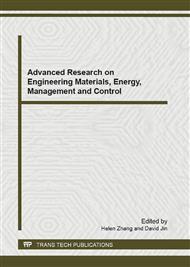
The SLS (Selective Laser Sintering, SLS) technology can directly manufacturing any complex structure, however, due to the limitation of the manufacturing engineering factor, the surface quality and the dimension accuracy of the green part are still an outstanding problem. So, the experimental methods were adopted to study the effect of part orientation on the machining accuracy, the part orientation will significantly affects the outline of the part due to the stair-stepping phenomenon, and then affects the surface quality and the dimension accuracy. The experimental samples of different part orientations including 0, 20, 45, 60, 90 degree were fabricated, and the results indicated that the stair-stepping phenomenon significantly affected by the part orientation, when the part orientation is 0, 45 and 90 degree, the dimension accuracy is best than other part orientation, it mean the stair-stepping phenomenon is smallest. So, when the part structure is complicated, the important structure dimension should be chosen the orientation 0, 45, or 90 degree
You might also be interested in these eBooks
Info:
© 2012 Trans Tech Publications Ltd. All Rights Reserved
[1]
Upcraft S., Fletcher R. The rapid prototyping technologies. Assembly Automation. 23(4): 318-330 (2003).
DOI: 10.1108/01445150310698634
Google Scholar
[2]
ONUH S. O., YUSUF Y. Y. Rapid prototyping technology: applications and benefits for rapid product development. Journal of Intelligent Manufacturing. (10): 301-311 (1999).
Google Scholar
[3]
Kumar S. Selective laser sintering: A qualitative and objective approach. JOM, 55 (10): 43-47 (2003).
DOI: 10.1007/s11837-003-0175-y
Google Scholar
[4]
Evans R.S., Bourell D. L. Beaman J. J., et al. Rapid manufacturing of silicon carbide composites. Rapid Prototyping Journal. 11: 37-40 (2005).
DOI: 10.1108/13552540510573374
Google Scholar
[5]
Ho H. C. H., Cheung W. L., Gibson I. Morphology and properties of selective laser sintered bisphenol-A polycarbonate. Industrial and Engineering Chemistry Research. (9): 1850-1862 (2003).
DOI: 10.1021/ie0206352
Google Scholar
[6]
Ho H. C. H., Cheung W. L, Gibson I. Effects of graphite powder on the laser sintering behaviour of polycarbonate. Rapid Prototyping Journal. 8(4): 233-242 (2002).
DOI: 10.1108/13552540210441148
Google Scholar
[7]
Wang C. j., Li X. S., Huang S. H. The Precision Analysis of SLS Prototypes. Journal of Huazhong University of Science and Technology(Natural Science Edition). 29(6): 77-79 (2001). (In Chinese).
Google Scholar
[8]
Fan Z. T., Huang R. Y., Xiao Y. J. Analyzing on the Precision of the Part Made by Selected Laser Sintering. Journal of Nanchang University(Engineering & Technology). 22(2): 6-10 (2000). (In Chinese).
Google Scholar
[9]
Fan K. M., Cheung W. L., Gibson I. Movement of powder bed material during the selective laser sintering of bisphenol-A polycarbonate. Rapid prototyping Journal. 11(4): 188-198 (2005).
DOI: 10.1108/13552540510612884
Google Scholar
[10]
Balasubramanian B. Study of the selective laser sintering of metal-polymer powders: [Ph.D. Dissertation], The University of Texas at Austin, Austin, Texas (1995).
Google Scholar
[11]
Koo J. H., Lao S., Ho W., et al. Polyamide nanocomposites for selective laser sintering, Solid Freeform Fabrication Proceedings. 392-409 (2006).
Google Scholar


